Authors: Nusrat Jahan Mim
Posted: Tue, August 19, 2025 - 10:24:00
At just 19, the dabbawala who calls himself Junior Sharruk navigates the labyrinthine streets of Mumbai with astonishing precision. Adopting his name in homage to the 59-year-old Bollywood icon Shah Rukh Khan, Sharruk is a recent addition to Mumbai’s renowned dabbawala network, an informal, human-coordinated logistics system composed of nearly 5,000 couriers who collectively deliver more than 200,000 home-cooked meals every day to workplaces across the city. Assigned to the Mangaldas Market area, he personally handles 34 clients who work in office buildings and small shops. Despite having no access to GPS, databases, or real-time routing algorithms, Sharruk quickly mastered the intricate, analog infrastructure of the system: a semiotic code of hand-marked Devanagari script and color patterns inscribed on each tiffin, paired with an embodied understanding of the city’s spatial rhythms. Relying on intergenerational mentorship, community-encoded logic, and a finely attuned visual memory, he performs logistical intelligence with remarkable efficiency. When I asked how he memorizes so many routes, lanes, and buildings without digital maps, he smiled and said, “The city has its own colors, and I cannot unsee them.”
Junior Sharruk works in the same city that hosts Swiggy and Zomato, India’s major app-based food delivery services that operate similarly to Uber Eats, among other platforms. This juxtaposition illustrates how Mumbai simultaneously accommodates multiple temporalities [1], sustaining both analog, community-based systems such as the dabbawalas and hyper-digitized, algorithmically managed platforms. The city balances these overlapping timelines, absorbing the frictions that emerge where they meet. For instance, a single road may host digital billboards, shrines, street vendors, and metro stations—all part of the same spatial ecology. On one hand, Mumbai continuously produces new data, including mobile apps, sensors, and digital transactions, in its effort to remain legible to global technology trends. On the other hand, a substantial portion of its economic activity, mobility, and spatial coordination remains undocumented, embedded within informal systems that operate outside the scope of digital governance. This dual character is not unique to Mumbai. Cities across South Asia, including Dhaka, Karachi, and Kolkata, similarly rely on dense, interdependent networks of informal labor, community relationships, and vernacular practices. But this is not just a matter of the formal versus the informal. South Asian cities are shaped by the coexistence of modern and traditional infrastructures, secular and religious rhythms, colonial layouts and postcolonial adaptations.
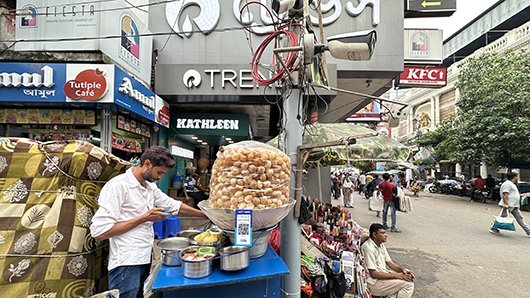
Millions of informal vendors are an integral part of Kolkata’s streets, conducting their livelihoods largely beyond the reach of formal records.
While cities cannot be entirely understood through data alone, those in the West are increasingly governed as if they can—through real-time dashboards, predictive analytics, and data-centric policy infrastructures. In contrast, many South Asian cities function through layered forms of informal coordination, where data is often sparse, fragmented, or intentionally bypassed. There, daily life continues to depend more on relationships—with the city’s people, land, built environment, institutions, and infrastructure—than records. Urban negotiations and decisions are not made through optimization, but rather through deliberation, trust, and often social pressure, which are the mechanisms of accountability that are embedded, not encoded. These cities rely on redundant human networks of multiple caregivers and informal safety nets.
Urban infrastructure here plays multiple roles. Streets double as social spaces, religious grounds, and informal markets. In Dhaka, the roads in front of mosques transform every Friday into open-air prayer grounds during Jumma, reconfiguring traffic flows and spatial priorities without any formal intervention. In Kolkata, during the Durga Puja festival, entire neighborhoods are reshaped by pandals—elaborate, temporary pavilions constructed to house devotional displays and communal rituals. These structures emerge in parks, intersections, and alleys, often overriding the normative logics of land use and secular public space. For several days, they rescript the spatial grammar of the city, drawing millions of devotees into improvised pedestrian zones thick with sound, scent, and collective participation. These spatial reconfigurations are not anomalies or exceptions. They are spontaneous and cyclical urban phenomena that defy prediction, resisting capture by data models predicated on stability and linearity.
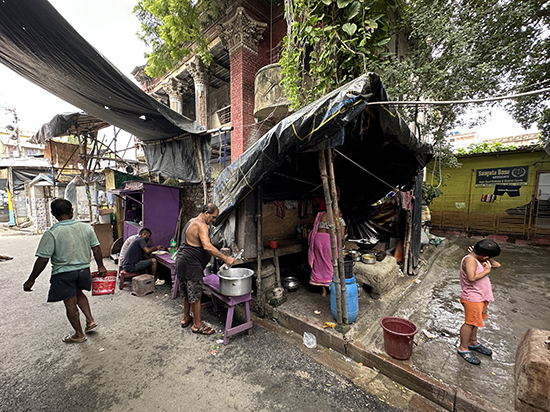
In old neighborhoods, local roadside eateries often serve as the main source of vegetarian meals for informal workers. Lacking any Google reviews, they thrive on the satisfaction and loyalty earned from each meal they serve.
In today’s world, shaped by big data, machine learning, and the expanding reach of AI, cities across the Global South are frequently labeled as “data poor” [2], a designation that often carries a negative connotation. In popular narratives and development discourse, this term implies not just a lack of infrastructure but also a form of urban backwardness, echoing the logics of 20th-century modernization theory that equates progress with quantification, planning, and technological visibility [3,4]. These narratives assume that, without dense sensor networks, digitized civic records, standardized taxonomies, and labeled datasets, cities are unprepared to enter the so-called AI era. This framing renders cities that operate through informal economies, oral knowledge systems, and plural governance structures as deficient or delayed, rather than differently organized [5,6]. AI systems, by design, learn by detecting statistical regularities in structured data. When data is partial, inconsistent, or unstandardized, as is often the case in cities with long-standing traditions of informal coordination, AI either fails to perform or misrepresents the social reality. Yet rather than questioning AI’s epistemic limits, dominant frameworks tend to treat the absence of data as a problem to be fixed.
But what if these cities are not data poor, but rather unreadable to systems built elsewhere? What if we say that AI lacks the capacity to learn from the kinds of knowledge these cities produce? Cities shaped by oral transmission, relational infrastructures, informal labor, and spiritual spatialities do not conform to AI’s preferred input formats; they resist flattening into labeled datasets and standardized categories. These are not broken systems waiting for technological repair; they are functioning systems organized around logics that AI is not built to recognize. In this light, the so-called data-poor cities do not simply represent a developmental lag. They expose the limitations of AI’s epistemology, its dependence on visibility, quantifiability, and repetition, and thereby act as sites of resistance to the totalizing claims of algorithmic urbanism. These cities remind us that intelligence does not always come in the form of optimization, prediction, and pattern recognition. It can emerge from improvisation, memory, and cohabitation. Rather than trying to make these cities legible to AI, we might ask what kinds of plural, situated, and relational intelligences become possible when we recognize that not all cities can or should be learned by machines. In doing so, these cities offer more than critique; they offer imagination, and alternative urban futures where technology listens more than it speaks, and where knowledge is not extracted, but lived.
Endnotes
1. Mehrotra, R. Simultaneous modernity: Negotiations and resistances in urban India. In Ruins of Modernity. J. Hell and A. Schönle, eds. Duke University Press, 2010.
2. Tonnarelli, F. and Mora, L. Responsible AI for cities: A case study of GeoAI in African informal settlements. Journal of Urban Technology 32, 3 (2025), 111-137.
3. Escobar, A. Encountering Development: The Making and Unmaking of the Third World. Princeton University Press, 2011.
4. Scott, J.C. Seeing Like a State: How Certain Schemes to Improve the Human Condition Have Failed. Yale University Press, 2020.
5. Kitchin, R. The real-time city? Big data and smart urbanism. GeoJournal 79, 1 (2014), 1–14.
6. Taylor, L. What is data justice? The case for connecting digital rights and freedoms globally. Big Data & Society 4, 2 (2017); https://doi.org/10.1177/20539517177363
Posted in: on Tue, August 19, 2025 - 10:24:00
Nusrat Jahan Mim
View All Nusrat Jahan Mim 's Posts
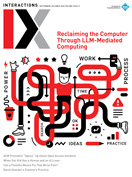
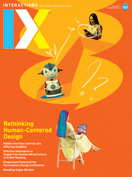
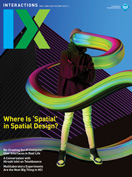



Post Comment
No Comments Found